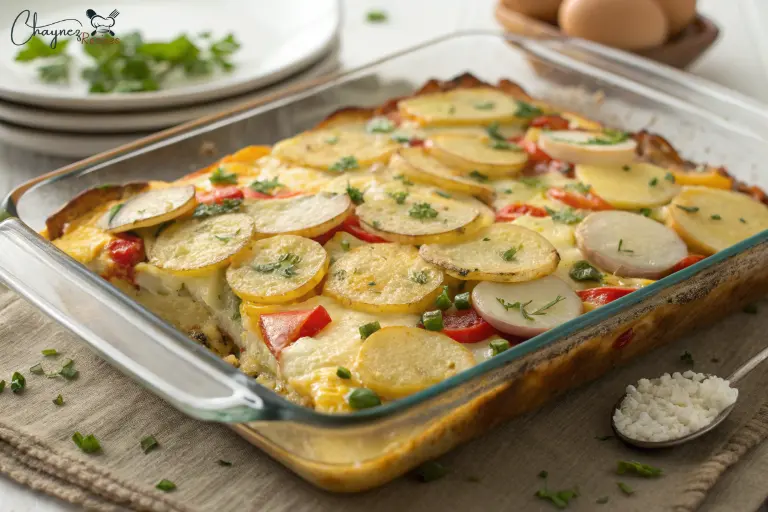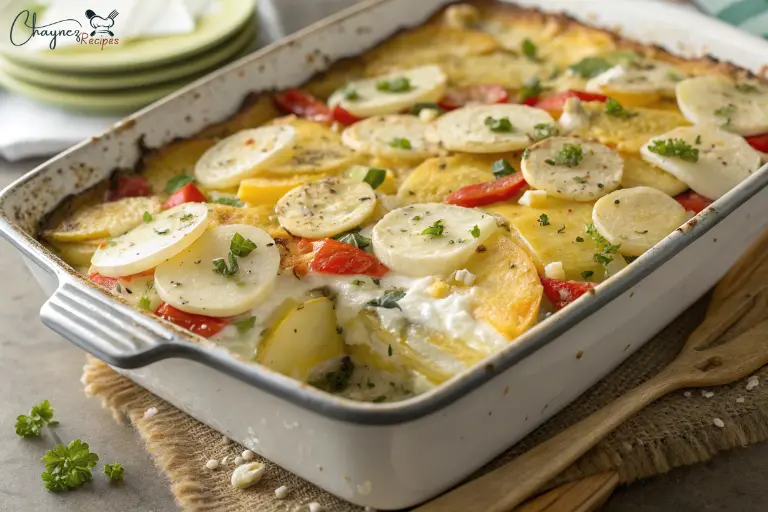If you’re searching for a delicious and satisfying breakfast option that caters to your gluten-free diet, look no further than a gluten free breakfast casserole with potatoes. This hearty dish is not only easy to prepare but also packed with flavor. It combines savory potatoes, eggs, cheese, and other fresh ingredients, making it an ideal breakfast for family gatherings, meal prep, or even a quick weekday meal.
In this article, we will guide you through the process of making a gluten free breakfast casserole with potatoes, offering tips, substitutions, and variations to suit different tastes. We will also discuss the benefits of this recipe, making it a great choice for anyone looking for a nutritious, filling, and gluten-free breakfast.
Why Choose a Gluten Free Breakfast Casserole?
For those following a gluten-free diet, finding satisfying breakfast options can sometimes feel like a challenge. However, this gluten free breakfast casserole with potatoes offers the perfect solution. Here’s why this dish should be part of your breakfast routine:
- Naturally Gluten-Free Ingredients: Potatoes, eggs, cheese, and vegetables are naturally gluten-free. By using these ingredients, you can create a flavorful and wholesome breakfast without worrying about gluten.
- Quick and Easy Preparation: This casserole is simple to assemble and bake. You can prepare it ahead of time, saving you time in the morning.
- Customizable: You can easily swap out ingredients to suit your dietary preferences, whether you prefer dairy-free, vegetarian, or protein-packed variations.
- Ideal for Meal Prep: A gluten free breakfast casserole with potatoes can be made in bulk and stored for several days, making it a perfect option for busy mornings.
Key Ingredients for Your Gluten Free Breakfast Casserole with Potatoes
The beauty of this dish lies in its simplicity. You likely already have many of the ingredients on hand. Here are the main components of a gluten free breakfast casserole with potatoes:
- Potatoes: Choose your favorite type of potato, such as russet, red, or sweet potatoes. These will serve as the base of the casserole.
- Eggs: Eggs provide structure and protein to the casserole, making it a filling breakfast.
- Cheese: Cheddar, mozzarella, or even a dairy-free alternative can be used. Cheese adds creaminess and flavor.
- Vegetables: Bell peppers, onions, spinach, or mushrooms can be added for extra flavor and nutrition.
- Meat: If you want to add a protein component, cooked sausage, bacon, or ham are excellent options. For a vegetarian alternative, tofu can be used.
- Seasonings: Salt, pepper, garlic powder, onion powder, and dried herbs like thyme or rosemary will enhance the flavor of your casserole.
How to Make a Gluten Free Breakfast Casserole with Potatoes
Creating a gluten free breakfast casserole with potatoes is straightforward and doesn’t require complicated steps. Follow this simple recipe to make your own casserole.
Ingredients:
- 4 large potatoes, peeled and diced
- 8 large eggs
- 1 cup shredded cheddar cheese (or dairy-free alternative)
- 1/2 cup milk (or dairy-free milk)
- 1 cup diced bell peppers
- 1/2 cup diced onions
- 1 cup cooked sausage or bacon (optional)
- 1 tsp garlic powder
- 1 tsp onion powder
- Salt and pepper to taste
- 1 tbsp olive oil for greasing the baking dish
Instructions:
- Preheat the Oven: Begin by preheating your oven to 375°F (190°C). Grease a 9×13-inch baking dish with olive oil or cooking spray.
- Cook the Potatoes: In a large skillet, heat a little olive oil over medium heat. Add the diced potatoes and cook for 10–15 minutes until they are soft and lightly browned. Stir occasionally to avoid burning.
- Prepare the Vegetables: While the potatoes are cooking, dice the bell peppers and onions. If you’re using sausage or bacon, cook them in a separate pan until crispy and set aside.
- Whisk the Eggs: In a large bowl, crack the eggs and whisk them together with the milk. Season with garlic powder, onion powder, salt, and pepper. You can also add herbs such as thyme or rosemary for added flavor.
- Combine the Ingredients: Once the potatoes are cooked, add them to the prepared baking dish. Mix in the vegetables, sausage (if using), and half of the shredded cheese. Pour the egg mixture over the top and stir to combine.
- Bake the Casserole: Sprinkle the remaining cheese on top and bake the casserole for 30–40 minutes, or until the eggs are set and the cheese is golden brown.
- Serve and Enjoy: Let the casserole cool for a few minutes before slicing and serving. It pairs well with fresh fruit or a side salad.

Tips for the Best Gluten Free Breakfast Casserole with Potatoes
Making a gluten free breakfast casserole with potatoes can be a simple and enjoyable process, but a few extra tips can help you perfect your casserole and elevate the flavor and texture. Here are some key suggestions to ensure that your casserole turns out as delicious as possible:
1. Choose the Right Potatoes
The type of potatoes you use in your casserole can significantly impact the final texture and flavor. Here’s a breakdown of different potato options:
- Russet Potatoes: These are starchy potatoes, making them an excellent choice for casseroles. Their high starch content allows them to break down slightly during cooking, creating a soft, creamy texture that pairs well with the eggs and cheese in the casserole.
- Yukon Gold Potatoes: These have a waxy texture and a slightly buttery flavor. They hold their shape better than russets, offering a firmer bite. If you prefer a less creamy but more structured texture, Yukon Golds are a good choice.
- Red Potatoes: These are waxy potatoes with a smooth texture and a slight sweetness. They hold their shape well and work great if you want small, bite-sized pieces in your casserole.
- Sweet Potatoes: If you’re looking for a slightly sweet and nutrient-packed variation, sweet potatoes are a great option. They add a natural sweetness and are packed with fiber and antioxidants, such as beta-carotene.
2. Pre-Cook the Potatoes for Optimal Texture
To prevent your gluten free breakfast casserole with potatoes from becoming soggy, it’s essential to pre-cook the potatoes. While you can technically bake the casserole without pre-cooking the potatoes, doing so will help them achieve a more desirable texture and reduce the baking time.
- Sautéing: Sauté diced potatoes in a skillet with a little oil until they are lightly browned and cooked through. This gives the potatoes a crispy edge and a tender interior that complements the other ingredients in the casserole.
- Boiling: Alternatively, you can boil the diced potatoes for 5–7 minutes until just tender but not fully cooked. Drain and add them to the casserole. This method saves time and is ideal if you’re prepping the dish in advance.
3. Consider the Balance of Vegetables
Adding vegetables to your casserole not only boosts its nutritional value but also contributes to its flavor and texture. Here are some vegetable tips to take your casserole to the next level:
- Don’t Overcrowd: While vegetables like bell peppers, onions, and spinach add great flavor, you should avoid overwhelming the casserole with too many vegetables. Overcrowding the dish with veggies can result in excess moisture, which could make the casserole soggy.
- Use Cooked or Sautéed Vegetables: Raw vegetables, especially mushrooms, can release a lot of water as they cook, potentially leading to a watery casserole. It’s better to sauté or roast vegetables like onions, peppers, and mushrooms beforehand to release any excess moisture.
- Go Seasonal: Experiment with seasonal vegetables like zucchini, spinach, or asparagus. Using in-season vegetables can add variety and freshness to your casserole while supporting a balanced, nutrient-rich meal.
4. Season Well for Maximum Flavor
Seasoning is one of the most important elements of any casserole, and it’s no different with a gluten free breakfast casserole with potatoes. Potatoes themselves are quite neutral, so they need bold flavors to shine. Here are some tips on seasoning:
- Don’t Skip the Salt: Salt enhances the natural flavors of the ingredients. Be sure to season the potatoes, eggs, and vegetables as you prepare them, and taste test the mixture before assembling the casserole. Adjust the salt as needed.
- Use Fresh and Dried Herbs: Fresh herbs like rosemary, thyme, or parsley can add a fragrant, earthy aroma to your casserole. Dried herbs are also effective but use them sparingly. A pinch of dried thyme or oregano works wonders.
- Add Garlic and Onion: Garlic powder and onion powder are classic seasonings that bring depth to the dish. If you prefer fresh garlic, sauté it briefly before adding it to the casserole to avoid any bitterness.
- Consider Heat: A small amount of chili flakes, cayenne pepper, or diced jalapeños can bring a delightful heat to your casserole. Don’t go overboard—just a little will add the perfect amount of spice to balance the richness of the cheese and eggs.
5. Choose the Right Cheese for Texture and Flavor
Cheese is a key ingredient that adds both flavor and creaminess to your gluten free breakfast casserole with potatoes. The type of cheese you choose can make a big difference in the outcome. Here are some cheese recommendations:
- Cheddar Cheese: A sharp or mild cheddar adds a tangy flavor that pairs well with the potatoes. It melts beautifully and gives the casserole a rich, comforting texture.
- Mozzarella Cheese: For a more stringy, gooey texture, mozzarella is a great option. It adds a mild flavor and a creamy texture that makes every bite satisfying.
- Gruyère or Swiss Cheese: If you want to introduce a slightly nutty, savory flavor, Gruyère or Swiss cheese is an excellent choice. These cheeses melt smoothly and add complexity to the casserole.
- Dairy-Free Cheese: For those with dairy restrictions, many dairy-free cheeses on the market today melt well and provide similar textures. Look for brands that use coconut milk or almond milk as a base for a more authentic melt.
- Cream Cheese or Ricotta: Adding a small amount of cream cheese or ricotta can make your casserole extra creamy and rich, giving it a luxurious texture without being overly greasy.
6. Don’t Overbake the Casserole
One common mistake when baking casseroles is leaving them in the oven for too long. Overbaking your gluten free breakfast casserole with potatoes can result in dry, rubbery eggs and burnt edges.
- Check for Doneness: The casserole is done when the eggs are set, and the cheese is golden brown. Insert a knife into the center—if it comes out clean, it’s ready. If it’s still a bit runny, give it a few more minutes, but check frequently.
- Let it Rest: After removing the casserole from the oven, let it rest for 5–10 minutes before slicing. This helps the casserole set properly, making it easier to cut into neat squares and ensuring that the flavors meld together.
7. Consider Making It Ahead of Time
One of the biggest advantages of a gluten free breakfast casserole with potatoes is that it’s great for meal prepping. You can assemble the casserole the night before, refrigerate it, and bake it in the morning.
- Refrigerating Overnight: After assembling the casserole, cover it tightly with plastic wrap or foil and refrigerate it overnight. This allows the flavors to meld, and the potatoes will absorb some of the egg mixture, making for a more flavorful dish.
- Freezing for Later: If you’re looking to make the casserole in advance for a busy week, this dish freezes well. Once baked, let it cool, slice it into individual portions, and store them in an airtight container. You can freeze it for up to a month. To reheat, simply microwave or bake at 350°F (175°C) for 15–20 minutes.
8. Use a High-Quality Baking Dish
Using the right baking dish ensures even cooking and proper heat distribution. Glass, ceramic, or stoneware baking dishes work well for casseroles because they heat evenly. Avoid using a dark metal pan, as it can cause the edges to cook too quickly, leading to burnt crusts.
By following these detailed tips, your gluten free breakfast casserole with potatoes will be a hit every time. Whether you’re preparing it for a special occasion, family breakfast, or weekly meal prep, these suggestions will help you achieve the perfect casserole with great flavor, texture, and versatility.

Variations of the Gluten Free Breakfast Casserole with Potatoes
One of the great things about a gluten free breakfast casserole with potatoes is how versatile it can be. Here are a few variations you might want to try:
1. Vegetarian Version
Skip the meat and load up on extra vegetables like spinach, mushrooms, and tomatoes. Add some feta or goat cheese for an extra burst of flavor.
2. Dairy-Free Version
Use a dairy-free cheese and substitute the regular milk for almond milk or another non-dairy option. Tofu can also be used as a protein source in place of meat.
3. Spicy Version
Add diced jalapeños or a few dashes of hot sauce to give the casserole a spicy kick. You can also sprinkle some chili powder or cayenne pepper on top.
4. Sweet Potato Breakfast Casserole
Swap out regular potatoes for sweet potatoes for a slightly sweeter flavor and a boost of nutrients like vitamin A.
5. Low-Carb Version
To reduce the carbohydrate content, use cauliflower rice instead of potatoes. It will still provide texture and absorb the flavors of the casserole.
Health Benefits of a Gluten Free Breakfast Casserole with Potatoes
Not only is this gluten free breakfast casserole with potatoes delicious, but it also comes with numerous health benefits. Here’s why you should consider adding it to your breakfast rotation:
- Rich in Protein: With eggs and cheese, this casserole provides a good amount of protein, which helps keep you feeling full and satisfied throughout the morning.
- Packed with Nutrients: Potatoes are a great source of vitamin C, potassium, and fiber, while vegetables add additional vitamins and minerals.
- Customizable for Dietary Needs: Whether you’re looking for a vegetarian, low-carb, or dairy-free breakfast, this casserole can be easily adapted to fit your dietary needs.
FAQs About Gluten Free Breakfast Casserole with Potatoes
1. Can I use frozen potatoes for a gluten free breakfast casserole with potatoes?
Yes, you can use frozen potatoes, but it’s best to thaw and drain them before adding to the casserole to avoid excess moisture.
2. How can I make my gluten free breakfast casserole with potatoes dairy-free?
Simply substitute dairy-free cheese and milk alternatives like almond milk or coconut milk. You can also use tofu or vegetables for extra protein.
3. Can I prepare the gluten free breakfast casserole with potatoes the night before?
Absolutely! You can assemble the casserole the night before, refrigerate it overnight, and bake it in the morning for a quick, hassle-free breakfast.
Conclusion: Gluten Free Breakfast Casserole with Potatoes
A gluten free breakfast casserole with potatoes is a fantastic option for a filling and nutritious start to your day. With its hearty ingredients and endless customization possibilities, this dish is sure to become a breakfast favorite. Whether you’re serving it at a weekend brunch or preparing it for an easy weekday meal, it’s both satisfying and simple to make.
If you’re looking for other creative recipes to complement your meals, consider trying our Salmon Poke Bowl, which offers a fresh and vibrant twist for a light lunch or dinner. Or, for a fun and customizable meal, our Poke Bowl Recipe provides a variety of toppings to suit every taste.
If you’re craving a dessert after your savory meal, why not indulge in a quick and easy Microwave Pumpkin Cheesecake? It’s the perfect solution for when you need a decadent treat in a hurry. Alternatively, for a more traditional cheesecake experience, check out our Pumpkin Cheesecake recipe, which brings the fall flavors to life in every bite.
With these tasty and versatile recipes, you’ll have no shortage of ideas to enjoy in the kitchen. Start with your gluten free breakfast casserole with potatoes and discover more delicious dishes to keep your meals exciting and satisfying!
Don’t miss out on more great ideas for healthier baking and cooking. For additional tips, recipes, and updates, follow us on Chaynez Recipes to access our latest posts and social media links.






